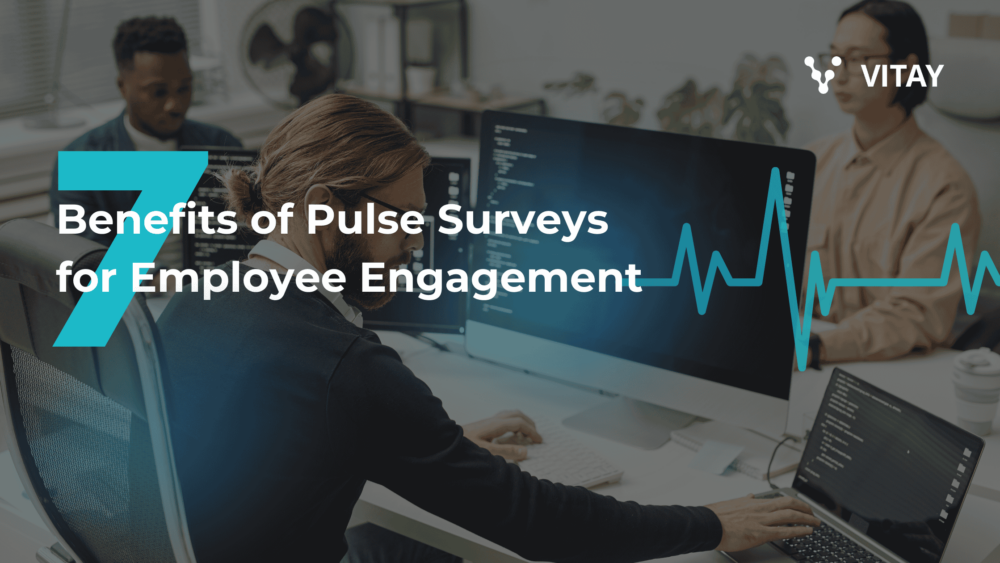As business leaders know, today’s workplace is competitive, with an emphasis on culture. In this environment, understanding your team’s sentiment is crucial for fostering a culture that entices employees.
Employee pulse check surveys have emerged as an effective tool for organizations to gauge employee engagement, satisfaction, and overall morale. Unlike traditional annual surveys, pulse checks are brief, frequent, and focused, allowing companies to stay attuned to their workforce’s needs. This article explores the top benefits of employee pulse checks and offers best practices for implementing them effectively.
The Top 7 Benefits of Employee Pulse Checks
Increased Employee Engagement
Regular check-ins through pulse surveys allow employees to voice their thoughts and feelings. This ongoing dialogue helps employees feel heard and valued, leading to higher engagement and commitment to their work.
Real-Time Feedback
One significant advantage of pulse checks is the ability to gather real-time feedback. Organizations can quickly identify issues or concerns and take immediate action, ensuring that employees feel supported and their concerns promptly addressed.
Improved Managerial Insights
Pulse surveys empower managers with data-driven insights into their teams. By analyzing survey results, managers can identify areas for improvement, tailor their leadership strategies, and enhance team dynamics, ultimately leading to better performance.
Identification of Trends
Frequent pulse checks enable organizations to uncover employee morale, satisfaction, and engagement trends. By tracking these metrics, companies can proactively address potential issues before they escalate, fostering a healthier work environment.
Cultivating a Culture of Trust
Open communication is essential for building trust within an organization. By encouraging employees to share their thoughts through pulse surveys, companies can create an atmosphere where feedback is welcomed and valued, ultimately strengthening relationships between employees and management.
Demonstrable Commitment to Employees
Regular pulse checks signal employees that the organization is committed to their well-being and professional growth. This investment in employee feedback reinforces the company’s dedication to fostering a supportive and responsive workplace.
Long-Term Retention
Organizations can significantly improve long-term retention rates by addressing employee concerns and enhancing engagement through regular feedback. Employees who feel valued and listened to are likely to remain loyal to their employer, reducing turnover costs and maintaining institutional knowledge.
Best Practices for Effective Pulse Checks
To reap the full benefits of pulse surveys, as well as to increase efficiency and efficacy, consider the following best practices:
- Frequency – Business changes quickly. Conduct pulse checks regularly (e.g., monthly or quarterly) to maintain a constant feedback loop. Your information will be more actionable regarding current circumstances, which means collecting surveys often.
- Anonymity – Research shows that anonymity yields more candid and accurate results. Ensure anonymity to encourage honest and candid responses from employees. Make sure to inform staff that the survey is anonymous and that you do not want to identify survey respondents.
- Brevity – According to the experts at Pew Research, the longer a survey is, the fewer people will take it. Keep surveys concise, focusing on key questions that provide actionable insights. This is easier to do if you conduct them regularly. If a certain question isn’t relevant, you can ask it on your next survey.
- Clarity – You don’t want to leave anything up for interpretation or misunderstanding. Use clear and straightforward language to avoid difficulties in survey questions. Employees should understand what you are asking from their first read.
- Diversity – Workplaces with a positive culture tend to be more diverse, with different perspectives adding to improved outcomes. Include a mix of quantitative and qualitative questions to capture a well-rounded perspective. Don’t be afraid to include questions that may have responses dependent on personal experiences.
- Technology – Use tech platforms wisely when administering your surveys. Digital tools can help you to distribute the surveys, keep them anonymous, and collect data. Vitay offers intuitive, reliable solutions for collecting pulse surveys from employees. The talent feedback platform allows companies to gather candid staff opinions, and collect them into valuable insights that can be used to improve.
- Follow-Up – To get the full benefits of pulse surveys, you need to keep employees in the loop throughout the process. Prior to the survey, let staff know that you’ll be sending a pulse survey and how the responses will be used. Communicate the results of the survey and outline the actions taken in response to employee feedback to close the feedback loop.
- Communication – Finally, communicating is important for closing that feedback loop. Sending pulse surveys and collecting employee insights is more than what many organizations do, but employees want to see more. Explain what’s being done as responses are being applied. If there is a task list that comes from the survey responses, explain that to the organization. You may even want to send a quarterly update with the action that’s been taken and what’s to come.
Taking action on survey results is paramount. Employees should see tangible changes based on their feedback, reinforcing the value of their input. It’s ok to give the update that you are evaluating the responses and putting together a team to address concerns and make changes – but make sure you follow through and prepare to take some action.
Employee pulse check surveys are a powerful tool for organizations looking to enhance workplace culture and employee satisfaction. By implementing regular check-ins and acting on the insights gathered, companies can foster a more engaged and committed workforce. For more workplace culture content and insights, be sure to check out our blog.




Comments are closed.